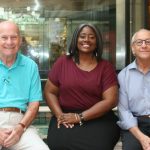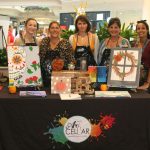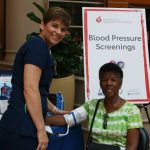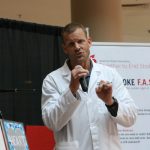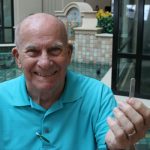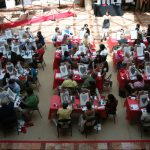By Callie Sharkey
The second annual Strokes for Stroke event returned to the Mall at Wellington Green on Saturday, Oct. 6, bringing nearly 70 participants of all ages together to paint and learn about stroke prevention and symptom identification.
According to the American Stroke Association, a division of the American Heart Association, stroke is the No. 2 cause of death worldwide and also preventable about 80 percent of the time.
“This event is a chance to highlight survivors and the journey they’ve made,” explained Beth Mourelatos, executive director of the ASA.
The ASA partnered with Wellington Regional Medical Center and the Art Cellar to bring this unique and free event to life. In addition to painting with instructor Brianna Speer, attendees enjoyed refreshments, learned about hands-free CPR, received blood pressure screenings and experienced simulated stroke symptoms for themselves.
Guest speakers included WRMC Chief Operating Officer Pam Tahan, emergency clinical care specialist Dr. Brandt Delhamer, and stroke survivors Jeffrey Skye, Latarsha Jones and former Wellington Mayor Tom Wenham.
Delhamer focused on the importance of knowing the signs and symptoms of a stroke. His mother, a registered nurse, died at the age of 47 after suffering a stroke and ignoring her symptoms. He explained the FAST acronym — Facial drooping, Arm weakness, Speech difficulty and Time to call 911 — and gave advice for people who see someone they suspect is having a stroke.
“Ask them to speak the phrase ‘no ifs, ands or buts,’ or extend both arms out to make a ‘T’ and note if one arm is lower than the other,” Delhamer recommended.
Wenham recalled his first stroke vividly. “I was peeling a banana in my left hand and I knew something was wrong,” he said. “I knew my brain was working, but I could not get to a phone.”
Instead, Wenham had to yell and wake up his wife so she could call 911. He praised Palm Beach County Fire-Rescue Station 25 and WRMC for their efficiency. He said that 42 minutes after his stroke, he was stabilized and knew he going to be OK.
“I cannot stress enough, please have a plan like me and my wife and know when to call 911,” he said.
Since his two strokes, Wenham now has a loop implant to monitor his heart in real time. He even has an app on his phone to track his symptoms and send information to his doctors immediately.
While their stories had common factors, each survivor’s situation is unique.
“You have permission to pause and take care of yourself,” said Jones, a former assistant principal who attributed her stroke directly to a highly stressed lifestyle that included caring for her ailing mother.
World Stroke Day falls on Oct. 29 and the ASA is working hard to train communities across the nation in the best ways to identify stroke symptoms. The FAST method is just that, an easy way to look for warning signs.
For more information about the Strokes for Stroke program or other AHA events, visit www.heart.org or call (561) 697-6600.




